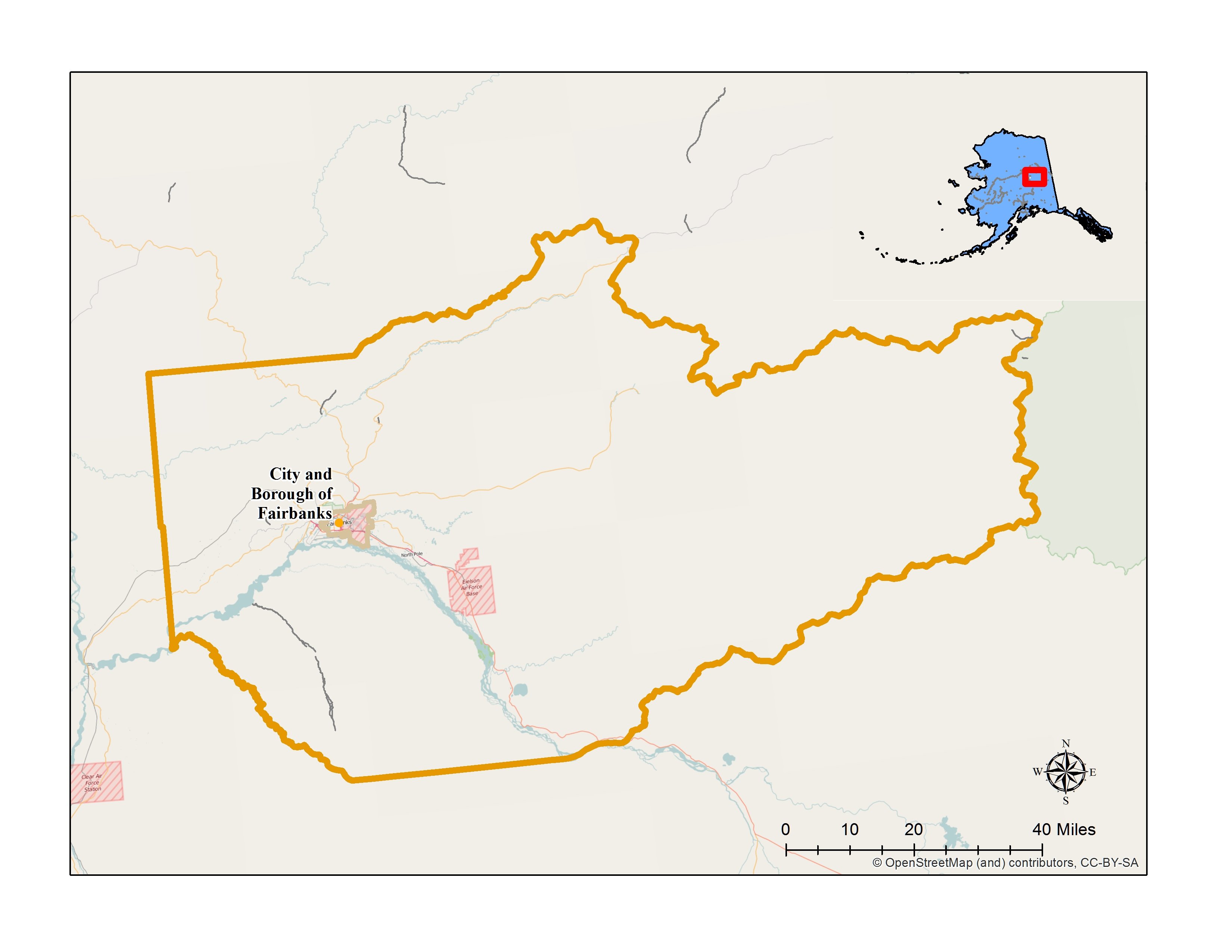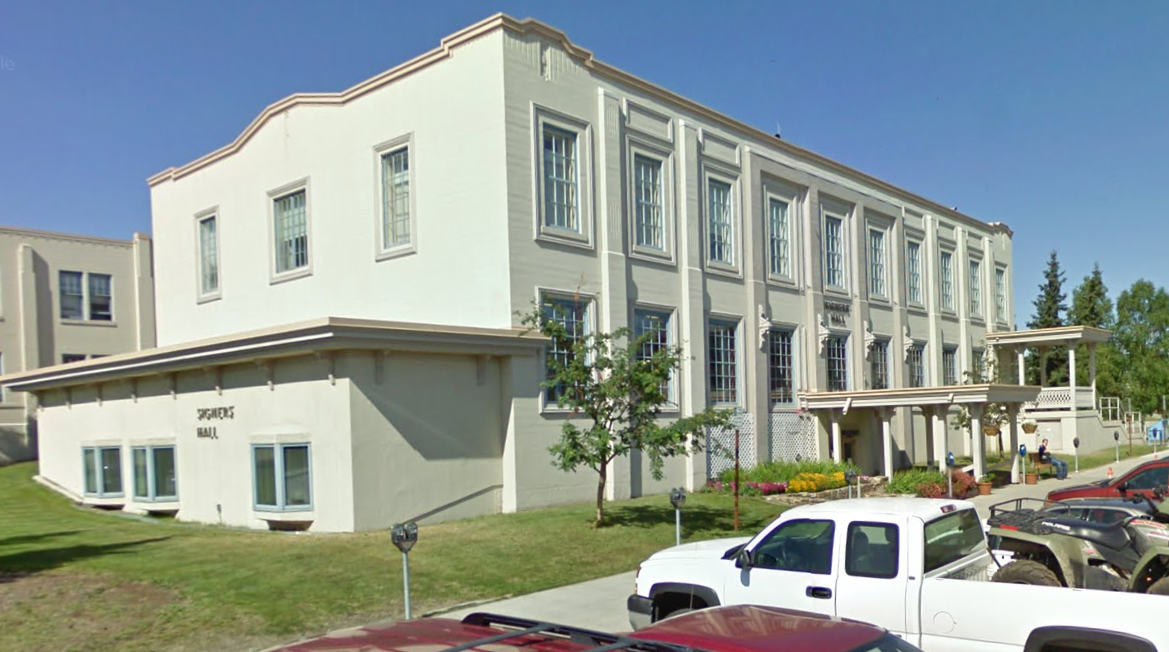Fairbanks
Fairbanks North Star Borough
2nd Class Borough
2015 Population: 97,972
Size: 7,466.14 Square Miles
City of Fairbanks
Home Rule City
2022 Population: 31,843
Size: 33.2 Square Miles

Fairbanks North Star Borough Joint Commission on Historic Preservation:
Established by ordinance under Chapter 2.64 to prepare and maintain an inventory of historical structures and sites in the borough, develop and maintain a local historical preservation plan, make recommendations on local projects affecting historic preservation, and review area nominations to the National Register of Historic Places. This commission is up for re-authorization every six years, by ordinance. This commission was reauthorized in 2012.
This commission has seven members. Four members shall be nominated by the Borough Mayor. Two members shall be residents of the City of Fairbanks and shall be nominated by the Mayor of the City of Fairbanks. One member shall be a resident from the North Pole community and shall be nominated by the Mayor of the City of North Pole. All members shall be confirmed by the Borough Assembly. One member shall, if possible, be an architect or an architectural historian. One member shall, if possible, be an archaeologist. One member shall, if possible, be a historian.
Date certified: 1992
Meets: Monthly
 Commission Website
Commission Website
Preservation Plan
Local district nomination process: Sec. 2-338
Alaskan Community Profile - City
-
CLG Grants

City of Fairbanks
Historic Preservation Development/Predevelopment Grants
Main School Classroom and Bleachers Restoration. 2012; 2011.
City Hall Roof Upgrade. 2000.
Commission Training Grants
Local Historic Preservation Commission Training, National Trust for Historic Preservation Conference. 2012.
National Alliance of Preservation Commissions Forum 2015.
CLG Workshop. 2001.Fairbanks North Star Borough
Historic Preservation Planning Grants
Fairbanks Historic Preservation Plan Update, 2016.
Historic Preservation Plan Update. 2002.Historic Preservation Plan. Phase I, 1994; Phase II, 1996.
Historic Resources Inventory. Phase I, Database for cultural resources inventory. 506 entries. 1993.
Survey and Inventory
Salcha and North Pole Historic Building Survey, 2017.
National Register of Historic Places Grants
Pioneer Park Historic District Nomination, draft, 2017.
Saving Historic Neighborhoods in Fairbanks: Illinois Street Historic District National Register Nomination. 1999.Historic Preservation Development/Predevelopment Grants
Riverboat Nenana Hazardous Materials Survey. 2004.
Historic Preservation Education Grants
Historic Building Signs. Phase I, 2009; Phase 2, 2011; Phase 3, 2013.
Fairbanks North Star Borough Historic Signage Plan. 2007.
The Historic Preservation Commission of the Fairbanks North Star Borough and the City of Fairbanks. 1992.
Commission Training Grants
National Alliance of Preservation Commissions Forum. 1997, 2001, 2005, 2008.
Economic Perspectives: Making the Historic Preservation Connection Workshop. 1993, 1994.
Alaska Historic Preservation Conference. 2015.
-
A Brief History
-
E.T. Barnette opened his trading post in 1901 at the site on the Chena River that became the town of Fairbanks because the steamboat he was on could get no further upriver. A year later, Felix Pedro discovered gold north of the site and announced his find at Barnette's post. Promoters soon chose to name the town after Indiana Senator Charles Fairbanks, acting on the suggestion by Judge James Wickersham, whom the promoters were courting to move his 3rd Judicial District headquarters to the new town. Wickersham moved the court from Eagle to Fairbanks in 1903.
While serving as delegate to Congress, Wickersham in 1917 got the government to establish the Alaska Agricultural College and School of Mines outside of Fairbanks, which soon became the University of Alaska. It remained Alaska's only post-secondary institution until the 1960s. In 1955-56 the delegates elected by the Territory of Alaska to write a constitution for the future state of Alaska met on the campus instead of in the capital city. In 1915, Wickersham held landmark meetings with Interior Athapaskan leaders about issues regarding land, reservations, and needs for education and jobs. Fairbanks later was an important center for organizers working to get Congress to pass the Alaska Native Claims Settlement Act in 1971. The regional corporation created under the law, Doyon Ltd., is the largest in number of members and amount of land received through the act.
Gold discoveries on a number of Fairbanks-area creeks after Pedro's discovery brought prospectors and business men and women, many from the Klondike and Nome, to Fairbanks. It became the supply and government center for interior Alaska. As the town outgrew its mining camp origins, concrete buildings replaced the log and wood ones. In addition to steamboats bringing supplies and people in the summer months, the Valdez-Fairbanks trail started to be upgraded by the government's new road building agency in 1905, first for year-round use by wagons and sleighs, and in the 1910s for trucks and automobiles. It was named the Richardson Highway for the Alaska Road Commission's first president. Not long after, Fairbanks became a hub for aviation. Fairbanks also was the destination for a number of companies attempting to build railroads from ports in southcentral Alaska, but it would take the federal government, with its deep pockets, to successfully complete one in 1923. Several short-distance railroads had been built earlier from Fairbanks to mining areas and were incorporated into the government's railroad. With the railroad and main highway, Fairbanks promoted the "Golden Circle tour" and billed itself as the "Golden heart of Alaska."
In 1926 the Fairbanks Exploration (F.E.) Company started large-scale dredge mining for gold in the area and established its headquarters across the Chena River from the city center. Almost a third of the city's population worked for the company in some capacity before the government shut down gold mining operations during World War II. After the war, the company resumed mining but closed for good in the 1960s because of high labor and freight costs and the low price for gold.
Establishing defenses around Alaska in the late 1930s, the U.S. Army built Ladd Field at Fairbanks and opened a cold weather testing facility there in 1938. Later it would add an airstrip at Mile 26 that became Eielson Air Force Base. During the war, the Americans transferred over 1,800 aircraft to the Russians under the Lend-Lease Program at Ladd Field. After World War II, the military stayed in Fairbanks as the United States built Cold War communication and defense posts fearing attacks from Russia to the west or over a polar route. In 1961, Ladd Field was renamed Fort Wainwright.
In 1964, the Fairbanks North Borough incorporated, but unlike a number of other places in Alaska did not merge with the City of Fairbanks. In 1967, the city built a major park now called Pioneer Park and planned a number of activities as part of the Alaska Purchase Centennial. In late summer, however the Chena River flooded the town. While the community was still recovering, the Prudhoe Bay oil discovery was announced. Fairbanks, about midway between the North Slope and Valdez, boomed as the staging, service, and supply center for construction of the trans-Alaska pipeline, completed in 1977.
Fairbanks today is Alaska's second largest city in population and is the regional hub of Interior Alaska for government, transportation, education, medical, and many other services.
-
-
National Register of Historic Places Listings
Chatanika Gold Camp Mile 27 3/4, Steese Hwy. Rainey's Cabin University of Alaska Ester Camp Historic District Off AK 3 Chena Pump House Chena Pump Rd. City Hall, Old 410 Cushman St. Clay Street Cemetery (AHRS Site No. FAI-164) 7th Ave. and Riverside Dr. Constitution Hall University of Alaska Davis, Mary Lee, House 410 Cowles St. Discovery Claim on Pedro Creek Mile 16.5 Steese Hwy. F. E. Company Housing 505, 507, 521, 523 Illinois St. F. E. Company Machine Shop 612 Illinois St. F. E. Company Manager's House 757 Illinois St. F.E. Company Dredge No. 2 Fairbanks Cr. F.E. Company Gold Dredge No. 5 Upper Dome Cr. Federal Building Cushman St. and 3rd Ave. Goldstream Dredge No. 8 Mile 9 Steese Hwy. Harding Railroad Car Alaskaland Hinckley-Creamer Dairy College Rd. Illinois Street Historic District 300-700 Illinois St. Immaculate Conception Church 115 N. Cushman St. Joslin, Falcon, House 413 Cowles St. Lacey Street Theatre 504 Second Ave. Ladd Field Ft. Wainwright Main School Seventh and Cushman Sts. Masonic Temple 809 1st Ave. St. Matthew's Episcopal Church 1029 1st Ave. S.S. Nenana Pioneer Park Oddfellows House 825 1st Ave. Rose Building 520 Church St. Thomas, George C., Memorial Library 901 1st Ave. Wickersham House Pioneer Park
